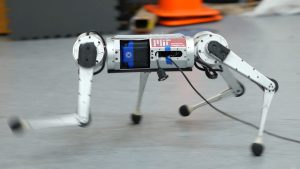
MIT’s Computer Science and Artificial Intelligence Laboratory (CSAIL) recently created a new version of a quick quadrupedal robot. Although four-legged robots have amassed a lot of popularity over the last few years, running is a skill that has eluded them.
This is because running in a real environment is extremely complex. The fast pace leaves almost no room for the robots to adapt to or recover from challenges such as physical obstacles or uneven terrain. Also, the burden of running stretches the hardware to its stress limits. MIT CSAIL PhD student Gabriel Margolis and Institute of AI and Fundamental Interactions (IAIFI) postdoc fellow Ge Yang said:
‘In such conditions, the robot dynamics are hard to analytically model. The robot needs to respond quickly to changes in the environment, such as the moment it encounters ice while running on grass. If the robot is walking, it is moving slowly and the presence of snow is not typically an issue. Imagine if you were walking slowly, but carefully: you can traverse almost any terrain’.
‘Today’s robots face an analogous problem. The problem is that moving on all terrains as if you were walking on ice is very inefficient, but is common among today’s robots. Humans run fast on grass and slow own on ice— we adapt. Giving robots a similar capability to adapt requires quick identification of terrain changes and quickly adapting to prevent the robot from falling over. In summary, because it’s impractical to build analytical (human designed) models of all possible terrains in advance, and the robot’s dynamics become more complex at high-velocities, high-speed running is more challenging than walking.’
Previously, the MIT Cheetah 3 and Mini Cheetah made use of nimble running controllers designed by humans who understood the physics of locomotion, created deficient abstractions and executed a specialized hierarchy of controllers to give the robot balance and enable it to run. It is the same way the Boston Dynamics’ Spot robot operates.
This novel system depends on an experience model to learn in real-time. With training of its simple neural network in a simulator, the MIT robot can obtain 100 days’ worth of experience in just three hours.
‘We developed an approach by which the robot’s behavior improves from simulated experience, and our approach critically also enables successful deployment of those learned behaviors in the real-world,’ Margolis and Yang explained.
‘The intuition behind why the robot’s running skill work well in the real world is: Of all the environments it sees in this simulator, some will teach the robot skills that are useful in the real world. When operating in the real world, our controller identifies and executes the relevant skills in real-time,’ they added.
The MIT Mini Cheetah is more evidence of concept and development than an actual end-product. The main idea here is how efficiently a robot can be created to adapt to the real world. Margolis and Yang noted that patterns of robotics development and deployment which need human supervision and input for effective operation isn’t ductile.
We’re slowly but surely getting to the point where simulations and neural networks can do a faster job of manual programming. The hardware and sensors of the past decades are now living to up to their full potential.
By Marvellous Iwendi.
Source: ZDNet